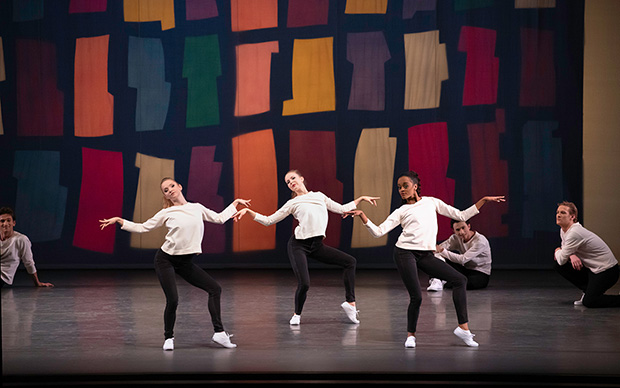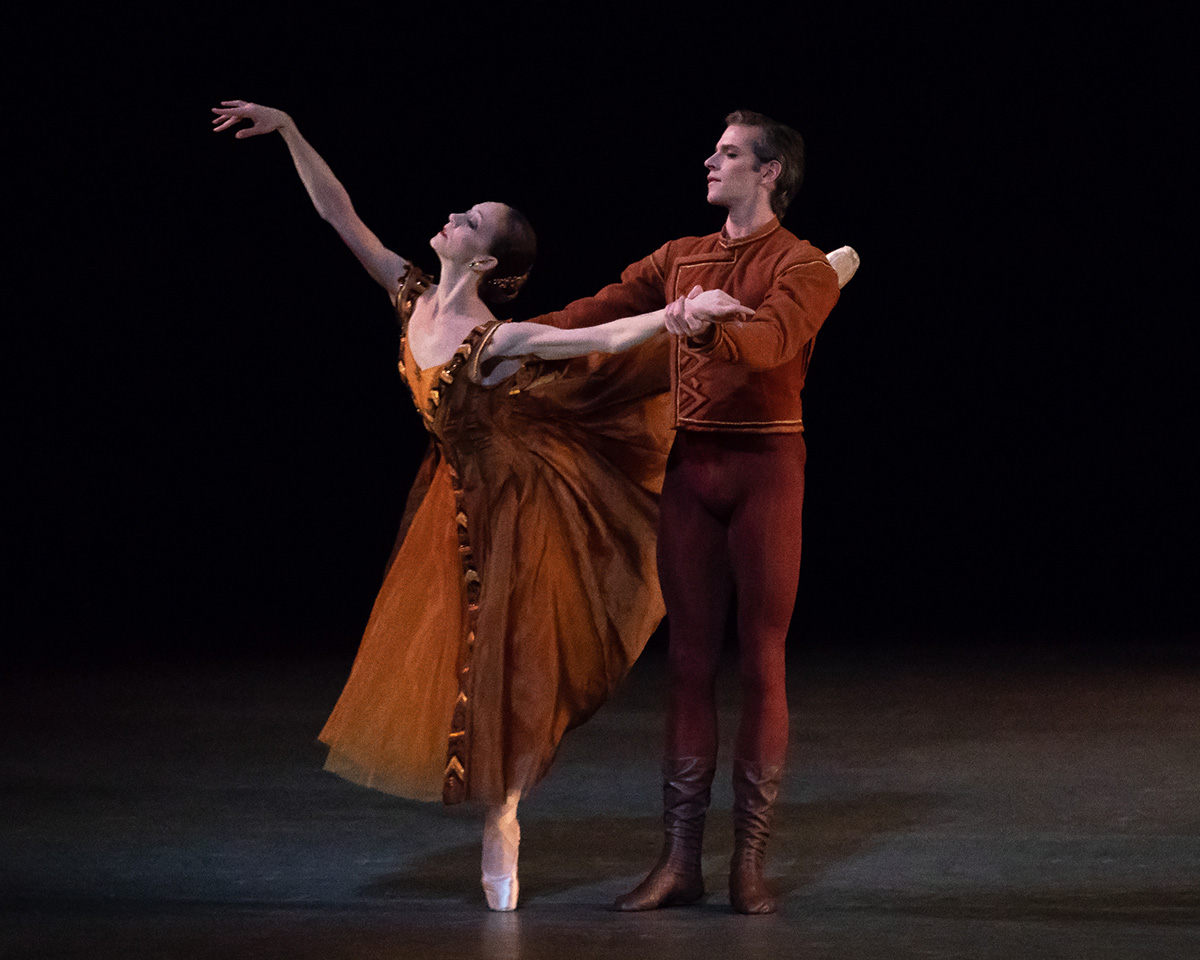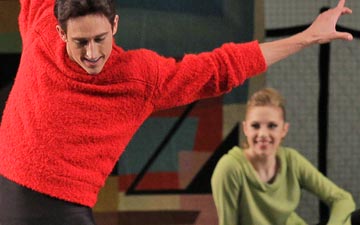
© Erin Baiano. (Click image for larger version)
New York City Ballet
Robbins: A Master at Work: Interplay, In the Night, N.Y. Export: Opus Jazz
★★★✰✰
New York, David H. Koch Theater
9 February 2019
www.nycballet.com
davidhkochtheater.com
It’s amazing what a swish of tulle and a bit of Chopin can do. Judging by the audience reactions to In the Night, Jerome Robbins’ elegant tribute to love, New Yorkers (and perhaps many of us in this modern world) need a lot more romance in their lives.
The audience gasped as the curtain went up on a pitch-black backdrop awash in glinting stars. A work for three couples set to Chopin’s nocturnes (played Saturday by Nancy McDill), In the Night drapes the women in long, full tulle dresses, and the men in smart but subtle waistcoats (original designs by sometime Robbins collaborator Joe Eula; this productions are by Sir Anthony Dowell).
Lauren Lovette and Joseph Gordon graced the stage Saturday night as the first couple, dancing to one of the more mournful nocturnes (Op. 27 No 1). Both enter the stage by walking backwards, before he lifts and carries her into a void of endless chivalry in what feels like a time long past. The lifts in Night range from the simplistically elegant to the utmost challenging (the second couple has an upside down, completely vertiginous lift), and it is in Night that we most see Robbins’ take on Balanchine’s mantra ‘Ballet is woman.’ The men are there, they are involved, they are (mostly) reliable, but the contrast in costuming is unmistakable: the women are the ones with the plumage (Dowell’s interpretation of the costumes really are the most lavish) while the men provide subdued, respectable support.

© Erin Baiano. (Click image for larger version)
Much of the choreography in Night is quite difficult but neither the dancers nor Robbins will let you see it. Lovette’s timing was exquisite and Gordon played the perfect courtly hand, they are a couple that represent love in full bloom: an experienced love that has withstood the kinds of trials (which, unlike the third couple, are not seen onstage) that makes love that much sweeter. Lovette and with her, Sara Mearns in the fiery third pas de deux, boasted sublime musicality.
As chandeliers drop from the ceiling, a sense of cloistered formality opens the second pas (Op. 55, Nos. 1 & 2). Starring Maria Kowroski and Russell Janzen, a couple with subtler if no less felt chemistry, the second pas has always been the most enigmatic. Opening with their arms linked, performing steps in sync, the couple appear to rediscover each other as the pas moves along. In a move iconic to this dance, Janzen swings Kowroski up, her feet pointing to the ceiling, her body straight as a rod but for her head turned sideways. Her foot gently beats her ankle, as he lowers her, as if her very soul is shivering. Are these the butterflies of love felt anew? I only wish Kowroski’s interpretation of this had been a touch more visible.

© Erin Baiano. (Click image for larger version)
Full to the brim of telenovela drama, the third, tempestuous pas de deux (Op. 9, No.2) was expertly performed by Sara Mearns and Jared Angle. The couple burn with fire as Mearns repeatedly flings herself at and tears herself away from Angle. Mearns eats up the dramatic opportunity and her portrayal as a woman of changeable moods makes her apology and supplication to Angle (a gradual kneel that ends with her unfurling her arms, palms up, on the ground at his feet) all the more moving. This couple is risky: Angle twirls Mearns around in a développé a la seconde that is fast, her axis tilted so much as to be borderline dangerous. The tulle of her skirt swishes audibly, a few times all aswirl in a 360 degree lift. The coda of Night is calmer, and akin to Dances at a Gathering the couples drift together as if meeting haphazardly, dance briefly before rejoining their partners in a soft waltz and the men lift their women offstage. There was virtually nothing to fault on Saturday night — each couple was well matched, and Robbins’ unique capacity to imbue classical form with the richness of human experience again seems unparalleled.
With their white socks and sneakers, N.Y. Export: Opus Jazz and Interplay are a world apart from the midnight realms Night conjures. Opus Jazz to my eye is the stronger of the two midcentury works: its formal structure is better defined, its cadences flow, and it rings with a sense of purpose that Interplay lacked, at least on Saturday night. Jazz is an exceptional ensemble opportunity, and soloists Harrison Coll and Peter Walker aside, was cast entirely with corps members. Spartak Hoxha and Roman Mejia in particular continue to impress with their sharp technique, keen musicality, buoyant leaps and winking eyes. I have seen both outperform dancers higher in rank in recent performances.

© Erin Baiano. (Click image for larger version)
A multi-section work set to a jazz score by Robert Prince, Opus pits dancers against one another in a joyous display of dance battles, everybody moving for him or herself alone, abandoning themselves to the music. Torsos sink low, knees bend, rumps stick out and fingers snap as jazz hands splay out in bold uninhibited gestures. Opus appears as an ode to youth of a certain time, a generation that got to embrace the strength and power of youth in a newfound way, less impeded by social formalities and constructs. The sets by Ben Shahn recall the mid-century graphics of Saul Bass or Alvin Lustig, costumes by Florence Klotz (loose t-shirts in primary and pastel colors and tight black pants with bare ankles and sneakers) still look crisp today. Prince’s score incorporates swing and hard bop styles of jazz, much of it (but not all) heavily percussive — evoking the turbulent restlessness of youth. The entire package is winning, and it’s almost impossible not to exit the theater with a swing in the step.

© Paul Kolnik. (Click image for larger version)
Interplay, premiered a good 13 years before Opus, and it shows. Set to a jazzy (but not jazz), brassy score by Morton Gould, Interplay is distinctly Robbins, but feels as if it is via Ashton even with a dash of Agnes de Mille. The cast Saturday night, while using many of the same dancers as in Opus, didn’t look well-rehearsed and it lacked the sharpness, verve and gusto the piece requires.

















You must be logged in to post a comment.